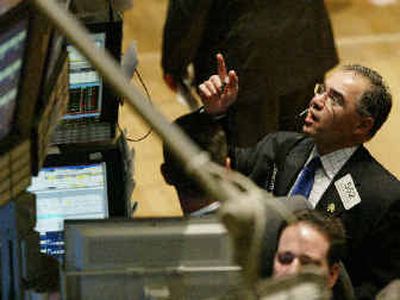Stock exchange caught between past and future

NEW YORK — The New York Stock Exchange’s planned merger with an all-electronic exchange raises many questions for the humans involved in stock trading — not just the hundreds of people who work the NYSE floor, but also the investors who buy and sell stock on the exchange.
The way the NYSE has traded stock has gone mostly unchanged for nearly 213 years, though certainly the volume of shares and the speed of transactions has picked up considerably as computers were brought in process trades. Yet the idea is the same — a floor trader walks up to an auctioneer, called a specialist, and places an order to buy or sell. The specialist finds someone else interested in that order and brokers a deal.
Now, those buyers and sellers are increasingly finding each other electronically and closing those deals in milliseconds. And the NYSE, facing increased competition from the Nasdaq Stock Market Inc. and other electronic markets, has embraced the technology with the merger with Chicago-based Archipelago Holdings Inc. that would also turn the currently not-for-profit NYSE into a publicly traded company called NYSE Group Inc.
“They absolutely had to do this deal, and it was a brilliant move,” said Jodi Burns, a senior capital markets analyst with Celent Communications. “The electronic markets have increasingly gained market share, even in NYSE-listed stocks. They had to act decisively, and boy, did they.”
The deal announced Wednesday was widely praised as a way to deal with a number of problems at the exchange, including the growing discontent of seat holders, or owners, who felt the NYSE wasn’t doing enough to make their investment worthwhile. The merger also addresses competition with all-electronic markets, gives the NYSE equity with which to make more deals and puts it on a level playing field with other global equity markets such as the London Stock Exchange and Germany’s Deutsche Bourse.
But in answering many of the outstanding questions about the NYSE’s future, Chief Executive John Thain raised new ones regarding the exchange’s world-famous trading floor, and whether investors will see any changes, for better or worse, in their transactions.
In announcing the merger, Thain said there were “absolutely no” plans to do away with floor trading. Indeed, the NYSE will continue to explore trading options, futures, exchange-traded funds and other derivative investments alongside its equities — and some of those derivatives could come from Archipelago, which has been making inroads in options trading, by the time the deal closes late this year or early in 2006.
But while the NYSE could take some derviative business from ArcaEx, the electronic trading platform could rob the floor system of trading volume — and that could have an impact on prices as well as the people who work there.
Within the specialist system, floor traders and specialists need a certain amount of critical mass in the number of shares traded in order to keep prices from becoming too volatile. If buyers and sellers are automatically matched via computer, then maintaining an orderly market in a stock becomes more difficult, since the real people on the floor of the NYSE will have fewer shares to work with.
For the most part, prices on all-electronic markets aren’t too much more volatile than on the NYSE. But when there’s exceptionally good or bad news about a given stock — or a general selloff or buying spree — an electronically traded stock tends to be far more volatile than a stock managed by humans.
And it’s that kind of price security that may make the floor traders and specialists a selling point for the combined NYSE Group, especially in competition with all-electronic markets such as the Nasdaq and many global exchanges.
“You know, a lot of people are belittling the role of the floor, and you would think that with the evolution of electronic trading, it becomes less important,” said Yakov Amihud, Rennert professor of finance at New York University’s Stern School of Business. “But in our research, we’ve found that in times of intense volatility, where do traders go? They go to the floor.”
If the floor traders do see less volume, that could mean fewer traders and fewer specialists will be needed to manage trades. While the big Wall Street firms such as Bear Stearns, Goldman Sachs, Merrill Lynch and Morgan Stanley could easily reabsorb unneeded floor traders and specialists into other areas of the firms, much of the floor is populated by smaller trading firms.